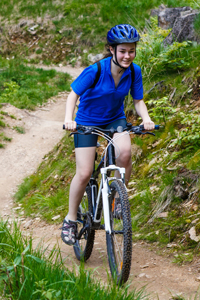 Sports injuries happen. When they do and the injury is bleeding, the quicker the blood is stopped the less likely you or others will be exposed to potential infection. If you train without the benefit of a training partner, have first aid supplies on hand to stop the bleeding until you locate others who can help in your care.
Sports injuries happen. When they do and the injury is bleeding, the quicker the blood is stopped the less likely you or others will be exposed to potential infection. If you train without the benefit of a training partner, have first aid supplies on hand to stop the bleeding until you locate others who can help in your care.
Choose items from these suggestions best suited for your training situation or to have during a sports event:
- Gauze pads
- Cotton nose plugs or cotton balls
- Water bottle or spray sanitizer
- Tape and pre-wrap
- Petroleum jelly
- Small bags for ice or snow
- Rubber gloves and other personal protective equipment
- Paper towels or regular towels
- Hydrogen peroxide (to get blood out of jerseys or sports clothing and gear)
Advice for treating common bleeding injuries:
Nosebleed
Stopping a nosebleed takes quick action. To help stop a nosebleed and keep it from restarting:
Pinch the nose bridge and lean forward over a garbage can. (Leaning backward isn't recommended because it allows blood to flow down the throat and into the stomach.)
Plug the bloody nostril with cotton nose plugs or cotton balls to help stop the flow of blood. Replace plugs as needed if blood flow continues. Remove plugs carefully since large blood clots may stick to the end. This is normal and usually means the nosebleed clotted on its own.
If blood flow continues, take a small bag of ice and place it on the nose bridge for at least five minutes. If bleeding continues, the nosebleed may be more serious and need a doctor's care to be cauterized.
Lacerations or cuts
If you're sweaty, a Band-Aid won't stick. Or, if the cut is too large (laceration), it may be hard to completely cover it. Keep the cut or laceration clean. Stop bleeding by applying pressure using a towel or gauze to stop blood flow so it can clot and be covered.
After bleeding has stopped, cover the injury with a gauze pad and wrap with pre-wrap and tape for the remainder of your training session or competition.
If the cut is deep and bleeding doesn't stop, or the cut is located on the face, stitches may be necessary. At events with medical coverage, usually medical staff can determine if stitches are needed and will apply a Steri-Strip™ to the cut to hold it in place until you can get stitches.
Petroleum jelly also can be used to stop bleeding in shallow cuts provided you remember to clean the wound thoroughly afterward to remove salve from the wound.
Abrasions or scrapes
Abrasions are common with trips and falls that happen on bike or running trails, cement or other road surfaces, or even on exercise or wrestling mats. An abrasion will continue bleeding if not covered.
After cleaning:
Apply pressure to the scrape using a towel or gauze. This may be enough to stop the bleeding.
Use petroleum jelly to stop bleeding if the skin is wiped dry before applying and the bleeding is minimal or has stopped.
Cover with gauze pads and pre-wrap, then secure with tape. To allow more movement, a stretchy tape rather than white athletic tape can be useful for knees and elbows.
Stopping bleeding and keeping the injury clean and covered are primary concerns. Keep these remaining tips in mind:
- Always remember to wash your hands after coming in contact with your blood or another athlete's blood.
- If bleeding is severe and you're coughing up or urinating blood or have abdominal pain, seek emergency room care immediately.
Clean the wound thoroughly after your workout or competition and with protective gloves, use a disinfecting spray to clean clothing or exercise equipment and places where blood has gotten on the floor.
If you have a suggestion for a topic to be covered in
Sports Wrap, email
sports.medicine@marshfieldclinic.org.
